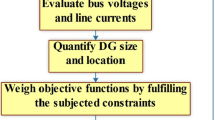Abstract
In this paper, a hybrid optimization method to optimally allocate wind turbines (WTs) in microgrids is proposed. The method combines genetic algorithm (GA) and optimal power flow (OPF) to jointly minimize total active power losses and maximize social welfare considering different combinations of wind generation and load demand over a year. The GA is used to choose the optimal size while the OPF to determine the optimal number of WTs at each candidate bus. The method is applied by microgrid operators to find the optimal numbers and sizes of WTs among different potential combinations. The effectiveness of the proposed method is demonstrated with an 83-bus 11.4 kV microgrid.






Similar content being viewed by others
References
Atwa YM, El-Saadany EF (2011) Probabilistic approach for optimal allocation of wind-based distributed generation in distribution systems. IET Renew Power Gener 5(1):79–88
Banosa R, Manzano-Agugliaro F, Montoya FG, Gila C, Alcayde A, Gómez J (2011) Optimization methods applied to renewable and sustainable energy: a review. Renew Sustain Energy Rev 15(4):1753–1766
Calderaro V, Piccolo A, Siano P (2005) Maximizing DG penetration in distribution networks by means of GA based reconfiguration. In: Proceedings of the international conference on future power systems, p 1–6
Borges CLT, Falcao DM (2006) Optimal distributed generation allocation for reliability, losses, and voltage improvement. Electr Power Energy Syst 28(6):413–420
Brunekreeft G (2005) Does ownership unbundling of the distribution networks distort the development of distributed generation? In: Proceedings of the fourth conference on applied infrastructure research, Berlin, pp 1–23
Castronuovo ED, Campagnolo JM, Salgado R (2001) On the application of high performance computation techniques to nonlinear interior point methods. IEEE Trans Power Syst 16(3):325–331
Cecati C, Citro C, Piccolo A, Siano P (2011a) Smart operation of wind turbines and diesel generators according to economic criteria. IEEE Trans Ind Electron 58(10):4514–4525
Cecati C, Citro C, Siano P (2011b) Combined operations of renewable energy systems and responsive demand in a smart grid. IEEE Trans Sustain Energy 2(4):468–476
Chen P, Siano P, Chen Z, Bak-Jensen B (2010a) Optimal allocation of power-electronic interfaced wind turbines using a genetic algorithm-Monte Carlo hybrid optimization method. Wind Power Systems, Springer, Berlin, pp 1–23
Chen P, Siano P, Bak-Jensen B, Chen Z (2010b) Stochastic optimization of wind turbine power factor using stochastic model of wind power. IEEE Trans Sustain Energy 1(1):19–29
Falaghi H, Haghifam M R (2007) ACO based algorithm for distributed generation sources allocation and sizing in distribution systems. In: Proceedings of the IEEE Power Tech conference, 1–5 July 2007, pp 555–560
Haghifam MR, Falaghi H, Malik OP (2008) Risk-based distributed generation placement. IET Gener Transm Distrib 2(2):252–260
Harrison GP, Piccolo A, Siano P, Wallace AR (2007a) Distributed generation capacity evaluation using combined genetic algorithm and OPF. Int J Emerg Electr Power Syst 8(2):1–13
Harrison GP, Piccolo A, Siano P, Wallace AR (2007b) Exploring the tradeoffs between incentives for distributed generation developers and DNOs. IEEE Trans Power Syst 22(2):821–828
Harrison GP, Piccolo A, Siano P, Wallace AR (2008) Hybrid GA and OPF evaluation of network capacity for distributed generation connections. Electric Power Syst Res 78(3):392–398
Jabr RA, Coonick AH, Cory BJ (2001) A primal-dual interior point method for optimal power flow dispatching. IEEE Trans Power Syst 17(3):654–662
MathWorks (2004) Genetic algorithms and direct search toolbox: user guide
Mokryani G, Siano P, Piccolo (2011a) Social welfare maximization for optimal allocation of wind turbines in distribution systems. In: Proceedings of 11th international conference on electrical power quality and utilization (EPQU), pp 1–6
Mokryani G, Siano P, Piccolo A (2011b) Optimal allocation of wind turbines in distribution systems based on social welfare evaluation. In: Proceedings of the IET conference on reliability of transmission and distribution networks, pp 1–6
Piccolo A, Siano P (2009) Evaluating the impact of network investment deferral on distributed generation expansion. IEEE Trans Power Syst 24(3):1559–1567
Qiu W, Flueck AJ, Tu F (2005) A new parallel algorithm for security constrained optimal power flow with a nonlinear interior point method. In: Proceedings of the general meeting at IEEE Power Engineering Society, June 2005, pp 2422–2428
Shrestha GB, Fonseka PAJ (2004) Congestion-driven transmission expansion in competitive power markets. IEEE Trans Power Syst 19(3):1658–1665
Siano P, Ochoa LF, Harrison GP, Piccolo A (2009) Assessing the strategic benefits of distributed generation ownership for DNOs. IET Gener Transm Distrib 3(3):225–236
Siano P, Chen P, Chen Z, Piccolo A (2010) Evaluating maximum wind energy exploitation in active distribution networks. IET Gener Transm Distrib 4(5):598–608
Singh RK, Goswami SK (2010) Optimum allocation of distributed generations based on nodal pricing for profit, loss reduction, and voltage improvement including voltage rise issue. Electr Power Energy Syst 32(6):637–644
Skytte K (1999) The regulating power market on the Nordic power exchange Nord Pool: an econometric analysis. Energy Econ 21(4):295–308
Zimmerman RD (2011) Manual MATPOWER. Available at http://www.pserc.cornell.edu/matpower/manual.pdf
Author information
Authors and Affiliations
Corresponding author
Rights and permissions
About this article
Cite this article
Mokryani, G., Siano, P. & Piccolo, A. Optimal allocation of wind turbines in microgrids by using genetic algorithm. J Ambient Intell Human Comput 4, 613–619 (2013). https://doi.org/10.1007/s12652-012-0163-6
Received:
Accepted:
Published:
Issue Date:
DOI: https://doi.org/10.1007/s12652-012-0163-6




